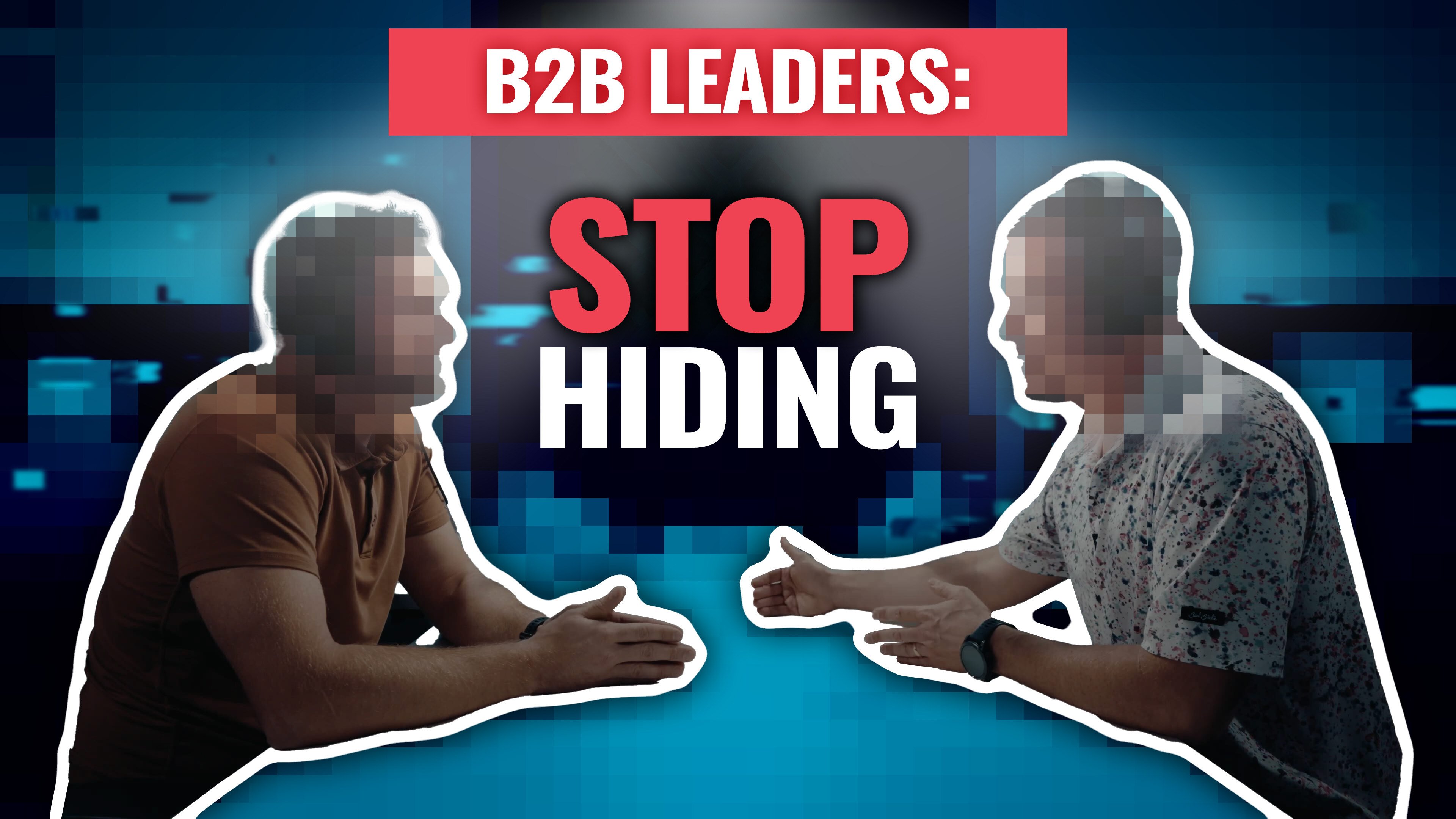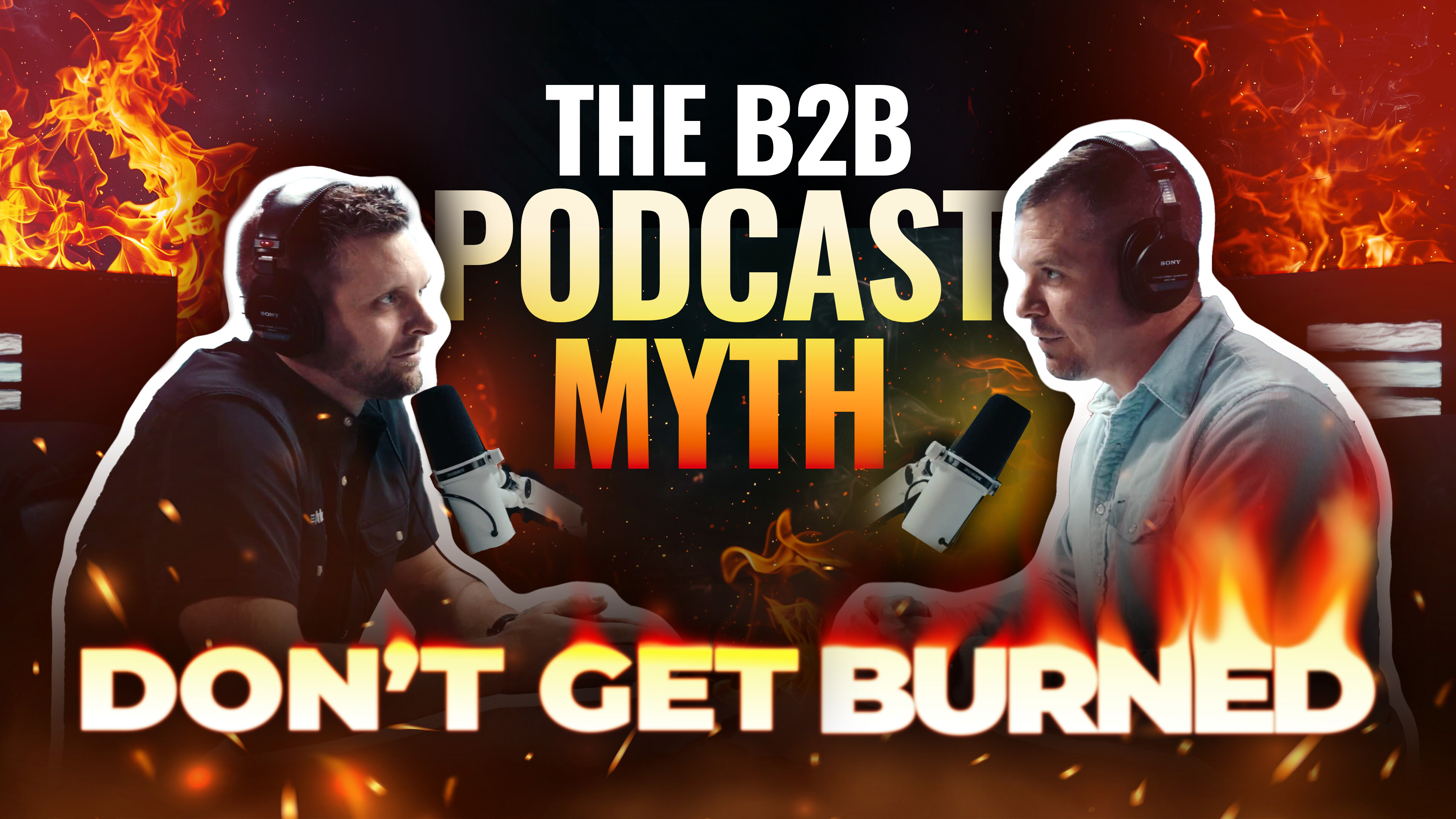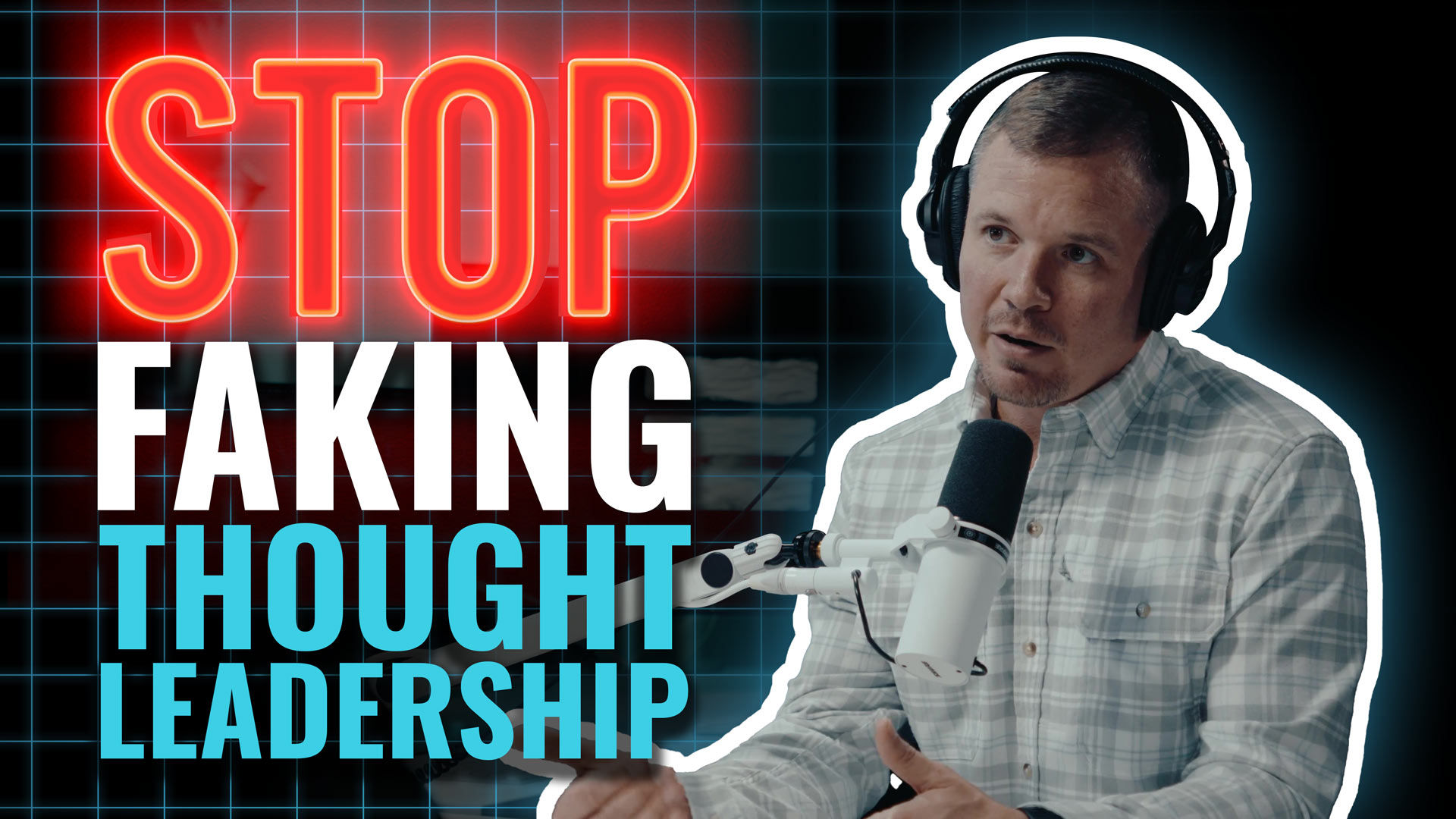
Why B2B Video Is Broken (And What No One's Telling You) - EP1 - Content Wars
🎯 B2B Marketers: Stop Wasting Your Video Budget!
In this episode of Content Wars, we expose the outdated thinking that’s sabotaging B2B video strategies. If you’re still treating video as a one-off asset, you’re leaving massive value on the table. Discover why the traditional production model is broken—and what modern B2B brands must do to scale video content and win audience attention.
💡 Key Takeaways: Why B2B companies treat video differently from all other content (and why it’s hurting them) The real reason most B2B videos never perform How traditional video production companies are misaligned with modern B2B needs Why lead-gen-focused content is failing—and what to replace it with A smarter, scalable approach to video that supports long-term strategy
⏰ Timestamps:
00:00 – The B2B video problem nobody’s talking about
02:00 – Why video gets treated as a “one-off”
05:00 – How B2B misuses video vs. B2C
07:00 – Lead generation fatigue and shifting buyer behavior
09:00 – Why production companies can’t support ongoing content
11:00 – The truth about one-time-use content
12:00 – How to rethink video as a repeatable message delivery tool
14:00 – The biggest unlock for B2B teams going into 2025
#B2BMarketing #VideoStrategy #ContentMarketing #ContentWars
Transcript
Nathan Yerian: It's just every single time that you talk to anyone about video, it's just the way that they're thinking about it. It's so limiting for the potential that they could possibly do. So I mean we've been doing video for, I don't know, let's just call it a decade. And still in that entire 10 year span, every single conversation that is started by a client or potential client is centered around a single deliverable. Every now and then it's maybe a series, but it's never an all-encompassing or continuing idea of how to use video on a repeat basis. And for me, I don't know, it's interesting because you get into B2B content or content in general and you're talking about whatever it is. It's a blog post, it is a webinar, it is a newsletter, it is a fill in the blank and there's some sort of repetition that's programmed into its very creation. Nobody says, you know what, let's create a blog article.
The end. It just doesn't happen. No one says that about a newsletter, no one says that about a webinar, no one says that about a podcast, no one says that about anything content-wise other than video. For me, I think that's a little bit awkward, a little bit backwards and definitely detrimental to their ability to communicate to their audience. After hearing this over and over and over again, I start asking myself, why is this the case? What is stopping an entire group of businesses from thinking about how to utilize a very powerful communication tool better?
What's the limiting factor here? Ultimately, what I came up with is it's probably partially my fault and the fault of every other person or company that is involved in video production as a whole. It's just that we present how it's always been done rather than how it could or in this case should be done in a B2B context. Video from the dawn of time has really been a one-off project-based thing. Yes, you could argue a television show is episodic in nature, but the way the production happens is not episodically that the production is happening one at a time. When you get into the commercial realm of things, which is most closely probably associated to what happens in B2B, you're talking about commercial production, you're talking about corporate production.
All of these things are based off of a one-off basis. You have a single need, you have an event happening, you have an announcement, you have a new product, you have a trade show, you have something that's fueling this need for a video, and then you take it to a production company. The production company's job is to produce that single video that works perfectly fine if you're in a commercial setting. Let's say you're going to get that one video and you need your entire audience to see that. Well, if I am in a B2C context and I produce that commercial, let's say it's a 30-second ad, now I have my piece of content and I need to get every one of my audience to see that, I already know that I'm going to spend a lot of money, more than the production itself, so that my audience sees it. We can really maximize that consumption of that message, that ad. I might spend, if we're talking about a true commercial, I might spend a quarter million dollars on the commercial, and I might spend two million dollars making sure that that commercial actually reaches that target audience. Whereas in a B2B context, I might spend $15,000 on my product launch video, and then I post it to my website that most of my audience is not on. I put it on my YouTube channel that most of my audience doesn't watch. Maybe I post it to LinkedIn and a couple people see it, and then that's it.
I might run a small campaign boosting a little bit within LinkedIn, but the majority of companies are running it so that there's really a lead generation aspect, not a true commercial component of it. So, they never really get the value of that type of production. For the production company, they don't know the difference. They say, okay, great, you paid me to create a video.
I give you that video. I'm now gone. I fulfilled my requirement. I need, for my business purpose, the way that I'm set up, I need to move on and go and find someone else that needs a video, because historically you have not needed perpetual video. You've needed a video. I need to find more people that need a video for my business model to work. And if I come back to you and say, hey, we did this video, it was $15,000, whatever it was, do you want to do another one?
Well, your answer is going to be, well, not right now. Maybe if we launch another product, we'll do another one, because you can't afford to continue to spend $15,000 on a continual basis doing video after video after video after video, even if that's what's best. It just isn't in your budget to do that. So there's a mismatch in how traditional production operates and the actual needs of of B2B companies in general.
Adam Marquardt: So unpack that. What are the needs that they actually need? And then how do they find or create or utilize a solution that actually moves them towards solving those needs?
Nathan Yerian: So the need is not unique in B2B. The need is you need people to consume your message. Now, historically, the past 10 years, the message has been very sales focused.
It's been very lead generation focused, is very buy now, buy now, buy now. And that's starting to fade away. People are tired of being sold to. They're tired of being told buy now, fill out this form, get this ebook, do the thing, harass by salespeople, the emails, the phone calls or whatever it is. As soon as you fill out a form, everybody knows what's going to happen.
Adam Marquardt: Is that because those things are not necessarily markers of intention?
Nathan Yerian: Yeah, because you fill out a form to potentially read an ebook, doesn't mean that you're ready to buy something.
Adam Marquardt: But B2B companies are treating it like it is.
Nathan Yerian: Many are, but I think a lot of them are waking up and saying, okay, look, we're going to be realistic. And we can go back and even look at it our own history. When we get 100 leads in, how many of those people actually turn into customers? It's going to be a very small percentage.
And it's going to be, in most cases, the same percentage that would have turned into customers anyway, because you have a small portion of your audience that is actively buying and the rest of them aren't. So you had 100 leads, you pissed off, 95 people by harassing them, emailing them, calling them, doing whatever it is. And five of them said, you know what, I'm actually interested in what you're talking about.
Let's have a conversation. Some companies look at that and go, okay, when we close five deals and some of them look at it and go, I like the five deals, but we might have just pissed off 95 potential future customers and the companies that are alert to or sensitive to that sort of environment where they're saying, hey, how do we not just focus on this 5% but how do we have a wider conversation with our entire audience? They have a different need for content and it's not lead generation based. It's how do we communicate our value to our full audience on a perpetual basis, not to make someone buy right now, but to allow someone to understand who we are, what we do, the value we offer, who we work with, all of the different components that would allow them to think of us first when they have a need, that becomes the new metric of what we're trying to accomplish. And for companies that are following that path and there are a lot of them starting to do so, one video doesn't get you there.
And that's where the need for more video comes, but it's been very restrictive for the companies that are realizing that and trying to move into that arena. They might try and do it themselves, right? So, hey, how do we do this?
Well, guess what? They have full-time jobs. They're not necessarily video professionals. They don't have the equipment in order to know how to operate it. Assuming they figure that out, there is a huge hurdle they have to get over in the editing aspect of things and actually turning it into something that matters, or in this case, a series of things that matter. So a lot of people try and look to outsource it in some way and they run into the same problem.
You call the video production team, they come in, they're like, okay, I wanna do whatever it is. It's gonna be even this, right? We're gonna do 50 episodes over the year. By the time you have a crew out to do 50 episodes, when you see that price tag, you're gonna say no, thank you.
That's just not possible. Even from a more, not necessarily episodic in this nature, but just come out and quarterly interviewing subject matter experts or whatever it is. If that's all you're doing, there's a disconnect between what that production company is going to think is gonna happen, which is delivering a video to you and what your expectation or what your true need is, which is we need 50 videos, 100 videos, or more out of that particular event. And again, that production company is not set up to operate in that type of arena and their price tag back to the business is going to prove that. They're perfectly suited for a commercial and announcement, a single video need. Not that single use videos are bad. There are instances in which they're good. In fact, we did a single use video for a client. They had a merger, two companies coming together.
The CEO wanted to announce the merger, talk about what it means for the company, what it means for the employees, what it means for the investors. That content is not reusable. It is a one-time event. Once that is watched and done, it's over. And that's fine.
That's perfectly suitable, normal for that particular video. But for 95% of the content that goes through B2B, it can be repurposed, it can be reused, it can have a greater shelf life, a greater return on investment. If it's treated in the proper way and if it is able to be broken down into a multitude of components that can be served out to a social audience for the company, for the thought leaders, used in sales conversations, used at trade shows, there's a multitude of ways that you can use the content if you're thinking about it in the correct way before you start planning what needs to be created.
Adam Marquardt: So what is the first step in that? Because I know that you said earlier about, you talked about 50 to 100 videos. And I know a lot of the people that we talk to, if we said 50 to 100 videos on day one, they would be shocked not being able to think about the depth of content they need. They might only be thinking of a video or two videos.
How or what do you start to do to wrap your brain around how to create content on a continual basis to where 50 to 100 videos sounds not only necessary, but approachable and something that they can actually execute on?
Nathan Yerian: Yeah, the easiest thing is stop thinking about video. So if you've been trained to think about video on a one-off basis, just take that and set it to the side and say, hey, we're not thinking about video right now, we're thinking about what is the message that we need to take to the audience? If you know what that message is, and you can figure out all of the different facets of how that should be delivered to an audience, include video at the end. Once you know what the message is, how we wanna say it, who needs to say it, where it needs to happen, what we need to show, what we need to tell, all the different components, and not on a one-off basis.
I mean, if your entire marketing boils down to what could be displayed to an audience in a two-minute video, I think you have a bigger problem. So there's an ongoing conversation, there's an ongoing value presentation that needs to happen, and there's different components and different pieces in there that need to be worked and reworked and stated different ways and shown different ways and proven in different ways. Once you plan that out, now you have a recipe and a template for the content that should be created. Now, whether that's dot leadership content, whether it's product content, whether it's case studies, whether it's branded content, it really doesn't matter because you know what that message is, and whether it would be video or written content or audio content, the format is less important than what is that message. If you have the message and you know what needs to be said, and I think B2B marketers have become very good at creating copy-based content in all of those arenas.
So it's a matter of taking that same exercise, that same mental approach for what you did when you thought it was gonna be copy and putting that aside for a second and saying, hey, just let's plan this out. I mean, some of the companies do two to three blogs per week and it's no problem, but when it comes to a video, they're like, I can only think of one, that's ridiculous. If you take the exact same content that was in your blog, you could probably turn it into a series of videos that would be available.
And now you've got a lot more content and you've got an entire slew of video ideas, not just a blog post or not just a webinar, not just whatever. None of these are mutually exclusive. You can do all of them and you probably should, but right now that isn't what companies do. They rule out video or they put it in a box and say it's only for this one thing. And that's, it's ridiculous. And it is very, very limiting for that company. It's very, very limiting for the way that they can actively communicate to their audience. And that's probably the number one thing that needs to change, I think, in a B2B setting. They just make that little switch about how you think about video, not being a one-off item that you need, a checklist item, but more of a vehicle to allow us to deliver our message better to our audience. I think that's gonna be probably the biggest unlock for most B2B teams going into 2025. The B2B is a B2B company.



